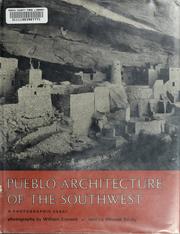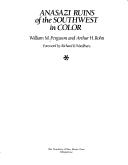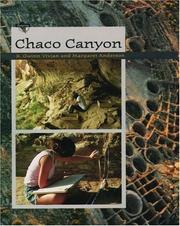| Listing 1 - 10 of 12 | << page >> |
Sort by
|
Book
ISBN: 1607817209 Year: 2020 Publisher: Salt Lake City, Utah : The University of Utah Press,
Abstract | Keywords | Export | Availability | Bookmark
 Loading...
Loading...Choose an application
- Reference Manager
- EndNote
- RefWorks (Direct export to RefWorks)
"There is a lack of a systematic understanding of Ancestral Pueblo color choices over time and this manuscript aims at compiling a more complete picture of the geographic and temporal distribution of color use in the Ancestral Pueblo world. The manuscript consists of two parts. The first examines color itself, through the science of color perception to the social significance of color in the human experience. It includes ethnographic and archaeological evidence for the production and use of color, including the technical and material constraints that shaped the use of color and the extent of archaeological preservation. The second part focuses on color across a range of material objects, including ceramics, painted murals, textiles, ornaments, rock art, and other painted items. These chapters identify patterns in color use over time, their geographic distribution, and the implications of color in the Ancestral Pueblo world"--Provided by publisher.
Ancestral Pueblo culture. --- Southwest, New --- Antiquities.

ISBN: 0292701209 Year: 1971 Publisher: Austin : Published for the Amon Carter Museum of Western Art, Fort Worth, by the University of Texas Press
Abstract | Keywords | Export | Availability | Bookmark
 Loading...
Loading...Choose an application
- Reference Manager
- EndNote
- RefWorks (Direct export to RefWorks)
Pueblo Indians --- Cliff-dwellings --- Pueblo (Indiens) --- Antiquities --- Pictorial works --- Dwellings --- Antiquités --- Ouvrages illustrés --- Habitations --- -Pueblos --- -Ancestral Pueblo culture --- Archaeology --- Pueblos --- Pictorial works. --- -Pictorial works --- Antiquités --- Ouvrages illustrés --- Ancestral Pueblo culture
Book
ISBN: 0873651987 9780873651981 Year: 1980 Publisher: Cambridge, Mass. Peabody Museum of Archaeology and Ethnology, Harvard University
Abstract | Keywords | Export | Availability | Bookmark
 Loading...
Loading...Choose an application
- Reference Manager
- EndNote
- RefWorks (Direct export to RefWorks)
Pueblo Indians --- Pueblos --- Pueblo (Indiens) --- Antiquities. --- Antiquités --- New Mexico --- Mariano Mesa region --- Nouveau-Mexique --- Ancestral Pueblo culture --- Dwellings --- Mariano Mesa region (N.M.) --- Antiquités --- Antiquities
Book
ISBN: 9781607816423 1607816423 9781607816416 Year: 2018 Publisher: Salt Lake City
Abstract | Keywords | Export | Availability | Bookmark
 Loading...
Loading...Choose an application
- Reference Manager
- EndNote
- RefWorks (Direct export to RefWorks)
"In this volume Steve Lekson argues that, for over a century, southwestern archaeology got the history of the ancient Southwest wrong. Instead, he advocates an entirely new approach, one that separates archaeological thought in the Southwest from its anthropological home and moves to more historical ways of thinking. Focusing on the enigmatic monumental center at Chaco Canyon, the book provides a historical analysis of how Southwest archaeology confined itself, how it can break out of those confines, and how it can proceed into the future. Lekson suggests that much of what we believe about the ancient Southwest should be radically revised. Looking past old preconceptions brings a different Chaco Canyon into view. More than an eleventh-century Pueblo ritual center, Chaco was a political capital with nobles and commoners, a regional economy, and deep connections to Mesoamerica. By getting the history right, a very different science of the ancient Southwest becomes possible and archaeology can be reinvented as a very different discipline."--Provided by publisher.
Chaco culture --- Archaeology --- Chaco phase --- Chacoan culture --- Chacoan phase --- Ancestral Pueblo culture --- Research --- History. --- Methodology. --- Southwest, New --- Chaco Canyon (N.M.) --- Antiquities --- Antiquities. --- Sunbelt States
Book
ISBN: 9781607817208 1607817217 9781607817215 1607817209 Year: 2020 Publisher: Salt Lake City
Abstract | Keywords | Export | Availability | Bookmark
 Loading...
Loading...Choose an application
- Reference Manager
- EndNote
- RefWorks (Direct export to RefWorks)
"There is a lack of a systematic understanding of Ancestral Pueblo color choices over time and this manuscript aims at compiling a more complete picture of the geographic and temporal distribution of color use in the Ancestral Pueblo world. The manuscript consists of two parts. The first examines color itself, through the science of color perception to the social significance of color in the human experience. It includes ethnographic and archaeological evidence for the production and use of color, including the technical and material constraints that shaped the use of color and the extent of archaeological preservation. The second part focuses on color across a range of material objects, including ceramics, painted murals, textiles, ornaments, rock art, and other painted items. These chapters identify patterns in color use over time, their geographic distribution, and the implications of color in the Ancestral Pueblo world"--Provided by publisher.
Ancestral Pueblo culture. --- Symbolism of colors --- Color --- Pueblo Indians --- Pueblo art --- Color in visual communication. --- History. --- Social aspects --- Material culture --- Antiquities. --- Southwest, New

ISBN: 0826308732 0826308740 Year: 1987 Publisher: Albuquerque, N.M. The University of New Mexico Press
Abstract | Keywords | Export | Availability | Bookmark
 Loading...
Loading...Choose an application
- Reference Manager
- EndNote
- RefWorks (Direct export to RefWorks)
Pueblo Indians --- Pueblos --- Ancestral Pueblo culture --- Antiquities --- Dwellings --- Southwest, New --- Antiquities. --- Architecture --- ruins --- Ancestral Puebloan --- Arizona --- Colorado --- New Mexico --- Utah --- Arizona [state] --- Colorado [state] --- New Mexico [state] --- Utah [state]
Book
ISBN: 0670582093 Year: 1975 Publisher: New York Viking press
Abstract | Keywords | Export | Availability | Bookmark
 Loading...
Loading...Choose an application
- Reference Manager
- EndNote
- RefWorks (Direct export to RefWorks)
Pueblo Indians. --- Pueblo architecture. --- Pueblos. --- 72.031.8 --- 72.031.4 --- 72.031.2 --- 72.03 --- Noord-Amerika --- Verenigde Staten --- Architecture, Pueblo --- Pueblo Indians --- Architecture --- Ancestral Pueblo culture --- Indians of North America --- Pueblo architectuur --- Pueblo indianen (architectuur) --- Traditionele architectuur --- Vernaculaire architectuur --- Volksarchitectuur --- Primitieve architectuur --- Architectuur (geschiedenis) --- Architectuurgeschiedenis --- Dwellings --- Pueblo architecture --- Pueblos
Book
ISBN: 0292737424 0292737416 0292737610 Year: 2012 Publisher: Austin : University of Texas Press,
Abstract | Keywords | Export | Availability | Bookmark
 Loading...
Loading...Choose an application
- Reference Manager
- EndNote
- RefWorks (Direct export to RefWorks)
Climate change is today’s news, but it isn’t a new phenomenon. Centuries-long cycles of heating and cooling are well documented for Europe and the North Atlantic. These variations in climate, including the Medieval Warm Period (MWP), AD 900 to 1300, and the early centuries of the Little Ice Age (LIA), AD 1300 to 1600, had a substantial impact on the cultural history of Europe. In this pathfinding volume, William C. Foster marshals extensive evidence that the heating and cooling of the MWP and LIA also occurred in North America and significantly affected the cultural history of Native peoples of the American Southwest, Southern Plains, and Southeast. Correlating climate change data with studies of archaeological sites across the Southwest, Southern Plains, and Southeast, Foster presents the first comprehensive overview of how Native American societies responded to climate variations over seven centuries. He describes how, as in Europe, the MWP ushered in a cultural renaissance, during which population levels surged and Native peoples substantially intensified agriculture, constructed monumental architecture, and produced sophisticated works of art. Foster follows the rise of three dominant cultural centers—Chaco Canyon in New Mexico, Cahokia on the middle Mississippi River, and Casas Grandes in northwestern Chihuahua, Mexico—that reached population levels comparable to those of London and Paris. Then he shows how the LIA reversed the gains of the MWP as population levels and agricultural production sharply declined; Chaco Canyon, Cahokia, and Casas Grandes collapsed; and dozens of smaller villages also collapsed or became fortresses.
Casas Grandes culture --- Chaco culture --- Indigenous peoples --- Mississippian culture --- Ecology --- Cahokia Mounds State Historic Park (Ill.) --- Aboriginal peoples --- Aborigines --- Adivasis --- Indigenous populations --- Native peoples --- Native races --- Ethnology --- Chaco phase --- Chacoan culture --- Chacoan phase --- Ancestral Pueblo culture --- Paquimé culture --- Cahokia Mounds (Ill.) --- Cahokia Site (East Saint Louis, Ill.) --- Illinois --- Antiquities --- Indians of Mexico

ISBN: 1280603275 1423774817 9781423774815 019028658X 0195142802 Year: 2002 Publisher: Oxford [England] New York Oxford University Press
Abstract | Keywords | Export | Availability | Bookmark
 Loading...
Loading...Choose an application
- Reference Manager
- EndNote
- RefWorks (Direct export to RefWorks)
Relates the nineteenth-century discovery of cliff dwellings in the Chaco Canyon of northwest New Mexico, the excavations of the ancient ruins, and what the artifacts reveal about the civilization of the ancient Pueblo Indians.
Chaco culture --- Cliff-dwellings --- Excavations (Archaeology) --- Pueblo Indians --- Indians of North America --- Cliff dwellings --- Archaeological digs --- Archaeological excavations --- Digs (Archaeology) --- Excavation sites (Archaeology) --- Ruins --- Sites, Excavation (Archaeology) --- Archaeology --- Dwellings --- Pueblos --- Chaco phase --- Chacoan culture --- Chacoan phase --- Ancestral Pueblo culture --- Antiquities. --- Antiquities --- Chaco Canyon (N.M.) --- Chaco Culture National Historical Park (N.M.) --- Chaco Canyon National Historic Park (N.M.) --- Chaco Canyon National Monument (N.M.)
Book
ISBN: 0826354793 9780826354792 9780826354785 0826354785 1306541239 Year: 2014 Publisher: Albuquerque, New Mexico
Abstract | Keywords | Export | Availability | Bookmark
 Loading...
Loading...Choose an application
- Reference Manager
- EndNote
- RefWorks (Direct export to RefWorks)
"At the height of their power in the late eleventh century, the Chaco Anasazi dominated a territory in the American Southwest larger than any European principality of the time. Developed over the course of centuries and thriving for over two hundred years, the Chacoans' society collapsed dramatically in the twelfth century in a mere forty years. David E. Stuart incorporates extensive new research findings through groundbreaking archaeology to explore the rise and fall of the Chaco Anasazi and how it parallels patterns throughout modern societies in this new edition. Adding new research findings on caloric flows in prehistoric times and investigating the evolutionary dynamics induced by these forces as well as exploring the consequences of an increasingly detached central Chacoan decision-making structure, Stuart argues that Chaco's failure was a failure to adapt to the consequences of rapid growth--including problems with the misuse of farmland, malnutrition, loss of community, and inability to deal with climatic catastrophe. Have modern societies learned from the experience and fate of the Chaco Anasazi, or are we risking a similar cultural collapse?"--
Pueblo Indians --- Chaco culture. --- Human ecology --- Social change --- Ecology --- Environment, Human --- Human beings --- Human environment --- Ecological engineering --- Human geography --- Nature --- Chaco phase --- Chacoan culture --- Chacoan phase --- Ancestral Pueblo culture --- Antiquities. --- Social life and customs. --- Social aspects --- Effect of environment on --- Effect of human beings on --- Chaco Canyon (N.M.) --- Social change. --- Human ecology. --- HISTORY --- Annals --- Auxiliary sciences of history --- Archaeological specimens --- Artefacts (Antiquities) --- Artifacts (Antiquities) --- Specimens, Archaeological --- Material culture --- Archaeology --- Change, Social --- Cultural change --- Cultural transformation --- Societal change --- Socio-cultural change --- Social history --- Social evolution --- State & Local --- West (AK, CA, CO, HI, ID, MT, NV, UT, WY) --- Southwest (AZ, NM, OK, TX) --- New Mexico --- Nuevo México --- Nuevo Méjico
| Listing 1 - 10 of 12 | << page >> |
Sort by
|

 Search
Search Feedback
Feedback About UniCat
About UniCat  Help
Help News
News